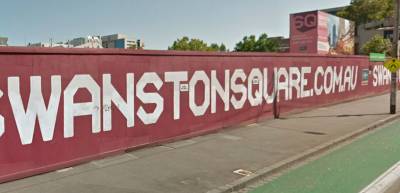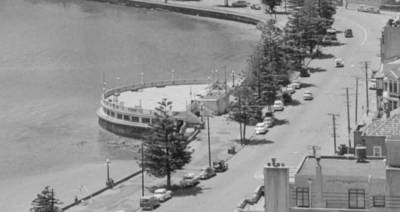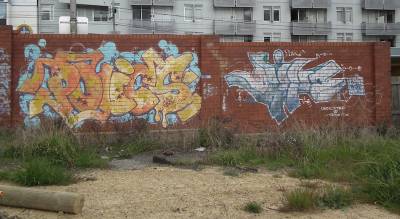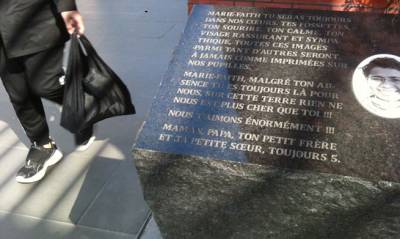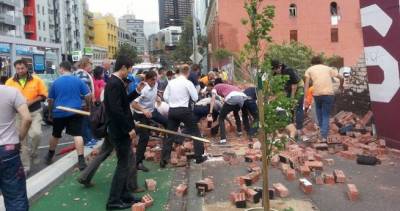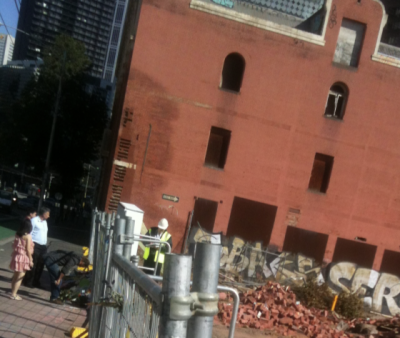home » news » urban design and heritage » Australia » Tasmania
Parliament Square - a year of it
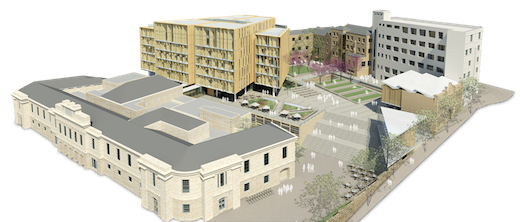
On the day before the night before Christmas, the latest episode in a year of courtroom tussling over a key site in Hobart.
At the Supreme Court of Tasmania’s last session of the year, Justice Wood upheld an appeal against the Appeals Tribunal’s determination that the Salamanca Place printing building was improperly listed on the heritage register used by the Heritage Council to approve its upcoming demolition. Phew. Easy to get that wrong, as the ABC appeared to – they illustrated their article with a picture of the State Offices at 10 Murray Street.
It has all gotten rather confusing this year as the Parliament Square proposal bounced around the Hobart courts. The confusion not helped by Newspeak press releases by the Tasmanian Treasurer Michael Aird:
“This revised planning application will run in parallel to the current appeal process for the original planning permit.” ( PDF )
That was an announcement in August for a new planning application by Citta Group, a month after a revised design was knocked back by the Resource Management and Planning Appeal Tribunal. The Tribunal appeared ticked off that, having had their original planning application approved by The Sullivans Cove Waterfront Authority, Citta Group came back with a larger design “in response to conditions of the permit”. The revisions would require substantial messing about with the Murray Street frontage and the public square in order to fit in another level of car parking, though this hadn’t been shown on the drawings. The Tribunal found that the revised design was just too far from the design that had been taken to the public in 2009:
“The proposal is fundamentally different. It is different in shape, size, impact, appearance and its relationship with its surrounds.”
Aird didn’t respond well to the Tribunal’s determination, saying that the revised proposal was in fact smaller than the original, and the, “the project will go ahead”. He told the Mercury he supported the application, and was considering special laws to fast -track the project. He has referred the Tribunal’s verdict to the Solicitor-General.
Developers Citta Group didn’t take the news too well either, lashing out at the government:
It seems to us extraordinary that we were encouraged by the Sullivans Cove Waterfront Authority to amend the design with their support but then had the amended project thrown out by the RMPAT with limited opportunity to present the proposal.
The Sullivan Cove Waterfront Authority is a government-appointed planning body that includes the State Government architect Peter Poulet on its Design Panel.
Aird’s frustration could to be due to his department’s twin responsibilities for offloading the eight government buildings as part of the Government Property Disposal Program, and running the development process. These don’t gel terribly well with the Tasmanian Justice Department’s diverse responsibilities for planning, design, and the courts.
In the Treasury’s Parliament Square FAQs , they ask themselves whether the parliament square redevelopment will be “part of the waterfront master planning”. ALthough the site falls within the boundary of the Sullivans Cove Master Plan, Treasury informs us that the, “recently appointed State Architect has been fully briefed on the PS redevelopment and will be mindful of it in his consideration of waterfront master planning.” They then refer back to their community consultation sessions in 2009 as if that was the end of the matter for them.
It was never going to be easy. One end of government sells off a block of government buildings to a developer for peanuts so that they will then rebuild some of them and lease them back to the government. Add other government departments less PPP-attuned. Add a bunch of 556 pesky architects and artists with their eyes on an old concrete building. And lastly, add one of the original architects, Dirk Bolt, questioning the sustainability of demolishing one tall building so that a 5 star one can be built:
There is a perception that 10 Murray Street is old-fashioned and that demolition is modern. This is mistaken. Demolition expresses the throw-away mentality that is as typical of the late 20th century as the building is of the 1960s but, like the building, the throw-away idea is no longer modern. In 2009, to be modern means to treasure both natural and built environments and to safeguard these as assets.
BUTTERPAPER 19.10.09 – 10 Murray St vs the square
BUTTERPAPER 28.09.09 – Another Brut to bite dust
SAVE 10 MURRAY
Posted by Peter on 04.01.11 in urban design and heritage
tags: 1960s, developers, dirk bolt, government buildings
comment
Commenting is closed for this article.
